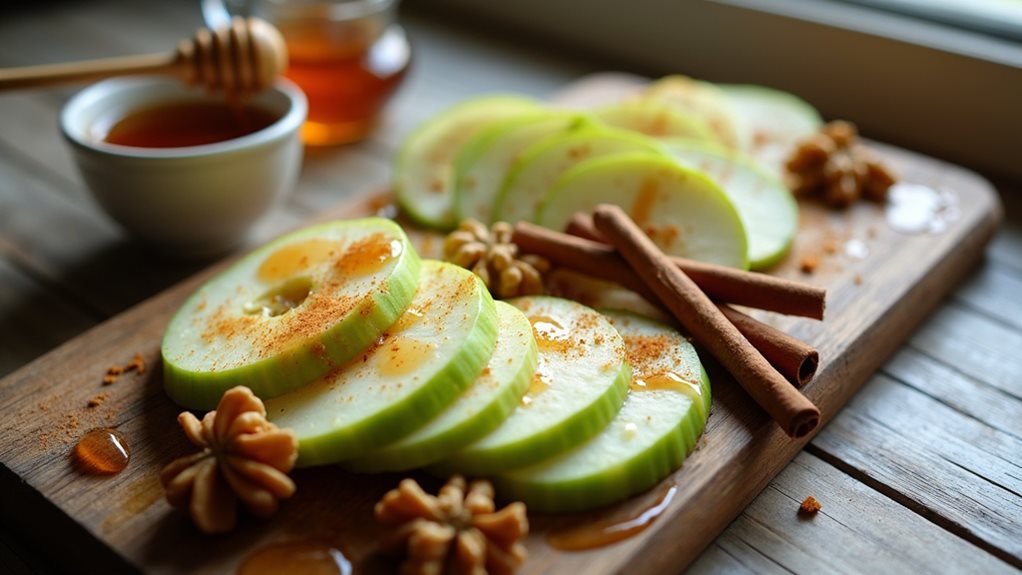Almonds pair wonderfully with chocolate, enhancing each other's flavors through shared compounds. You'll find magic when combining them with stone fruits like cherries and apricots or warming spices like cinnamon, cardamom, and nutmeg. For savory applications, try herbs like rosemary or spices like smoked paprika. Don't forget unexpected pairings—almonds complement charcuterie beautifully and add depth to beverages. A sprinkle of sea salt on sweetened almonds creates an irresistible contrast that'll transform your culinary creations.
The Unique Flavor Profiles of Almond Varieties

While many people think of almonds as having a single characteristic taste, the world of these versatile nuts offers a remarkable diversity of flavor profiles that can dramatically influence your culinary creations.
Explore the spectrum of almond flavor by incorporating different varieties into your recipes.
Marcona almonds deliver a sweet, buttery profile with a moist texture, perfect for gourmet applications, while Carmel almonds balance sweetness with subtle sourness.
If you're seeking less bitterness, Fritz almonds provide a sweeter, woodier almond flavor.
For baking projects, consider Monterey almonds with their meaty texture and balanced sweetness.
Don't overlook Aldrich almonds when working with desserts—their marzipan-like qualities make them ideal for confections where you want pronounced almond character without excessive bitterness.
Afghani Mamra almonds, with their distinctive crunch and somewhat bitter flavor, add complexity to savory dishes and spiced nut mixes.
Sweet almonds represent the most widely cultivated variety and offer a versatile option with their subtle sweetness and creamy texture for both sweet and savory dishes.
Classic Chocolate and Almond Combinations
Few culinary pairings achieve the perfect harmony of taste and texture found in chocolate and almond combinations. When you explore this classic duo, you're experiencing complex flavor chemistry at work—shared compounds like pyrazines and terpenes enhance each other's profiles while creating a satisfying contrast between smooth chocolate and crunchy almonds.
For ideal results, try tempering your chosen chocolate properly—whether it's rich dark or creamy milk varieties—and roasting almonds beforehand to intensify their nuttiness. Using real chocolate containing cocoa butter rather than compound chocolate varieties will produce superior chocolate almond clusters with better shine and snap.
You'll appreciate not just the sensory pleasure but also the nutritional benefits; this pairing offers protein, fiber, and antioxidants that contribute to satiety and overall health. The mechanical properties of this combination significantly influence consumer appeal and consumption decisions.
Customize your creations with sea salt or spices to elevate flavor dimensions, making this versatile combination perfect for both innovative desserts and mindful snacking options.
Fruit Pairings That Elevate Almond Flavors

Almond's versatility extends beyond its chocolate partnerships into the vibrant world of fruit pairings, where natural sweetness creates entirely new flavor dimensions.
The humble almond transcends its chocolate affinity, dancing with fruit's natural sweetness to craft unexplored flavor realms.
You'll find stone fruits like apricots, peaches, and cherries offer exceptional compatibility due to their botanical relationship with almonds, enhancing both flavor and fruit textures in desserts.
Citrus options provide bright contrasts—orange and lemon zest cut through almond's richness, while berries contribute both sweetness and acidity.
For more exotic combinations, try tropical fruits like mango or coconut with almonds. The addition of passion fruit creates an intriguing tropical complexity that works beautifully with almond's nutty character.
Banana and hazelnut create a surprising yet delicious combination that can be adapted to include almonds for a multi-layered nutty profile.
When planning your almond-based creations, consider working with seasonal fruits for peak flavor.
Summer's stone fruits and berries, autumn's apples and pears, and winter's citrus all provide different yet equally compelling companions to almonds' distinctive nutty profile.
Spice Combinations for Sweet and Savory Almond Dishes
Spices transform almonds from simple nuts into flavor powerhouses, whether you're creating decadent desserts or sophisticated savory dishes.
For sweet spice combinations, pair cinnamon with brown sugar for a traditional approach, or venture into more exotic territory with cardamom and nutmeg for unique sweetness. Ginger added to cinnamon creates a warm profile that complements almond's natural character.
On the savory side, explore Moroccan-inspired blends using cumin and coriander, or add depth with smoked paprika. Reviewers found that cumin can dominate when used in larger quantities, so adjust according to your preference for a more balanced flavor profile. Roasting almonds with herbs like rosemary at 425F temperature enhances their natural oils and creates perfect caramelization.
Za'atar offers Middle Eastern flair, while Chinese Five Spice brings complexity to roasted almonds. For heat lovers, combine chili powder with cayenne or experiment with garam masala for an Indian twist. Chinese Five Spice with almonds creates a naturally sweet undertone from its fennel, clove, and star anise components.
You'll find almonds readily accept both mild and bold spice profiles, making them perfect canvases for culinary exploration.
Almond Applications in Traditional Pastries

When you explore traditional pastries across the world, you'll find almonds taking center stage in creations like French almond croissants with their rich fillings and the intricately braided Danish pastries topped with flaked almonds.
You'll notice how different regions have developed their own specialties, from Italian amaretti to Spanish marzipan-based treats, each showcasing almonds' versatile flavor profile.
The secret to these beloved pastries isn't just in the ingredients but in the techniques—layering dough for flakiness, precise proving times, and careful temperature control that transforms simple almond paste into complex, aromatic delights. Many home bakers find that using pre-made puff pastry creates equally impressive results with less preparation time. Danish pastries particularly benefit from a leavened laminated dough that creates their signature light and airy texture, making them perfect for leisurely breakfast occasions.
Historical Pastry Traditions
The rich tapestry of almond-based pastries dates back centuries, particularly in Sicily where these beloved treats have become emblematic of the region's culinary identity.
Rooted in Middle Eastern almond origins and spreading through trade routes, these techniques evolved as they integrated with local ingredients and methods.
The cultural significance of almonds as symbols of fertility shaped their prominent role in celebratory desserts.
When exploring historical almond pastries, consider these fundamental traditions:
- Marzipan artistry – The 11th-century convent-born technique of crafting detailed Martorana fruits remains a representation of Sicilian craftsmanship.
- Resting rituals – Traditional recipes require patient dough resting, sometimes for hours, to develop complex flavors.
- Aromatic partnerships – Historic recipes pair almonds with citrus zest and honey, creating signature Mediterranean flavor profiles.
Regional Almond Specialties
Around the world, distinctive regional almond specialties have emerged from centuries of culinary tradition, each showcasing unique applications of this versatile nut.
Sicilian pastries feature premium Avola almonds, combined simply with sugar and egg whites to create elegant confections that highlight almond history through preserved techniques.
In Algeria, you'll find mchewek, where ground almonds provide the foundation for pastries enhanced with orange blossom water and lemon zest—a reflection of cultural hospitality traditions.
French regional recipes showcase almonds differently: Centre-Val de Loire's Pithiviers incorporates rich almond cream in its celebrated warm pastry, while Nantes cake from Pays de Loire utilizes almond powder for depth.
When exploring these specialties, you're not just tasting a dessert but experiencing centuries of cultural evolution and regional identity.
Texture and Technique
Mastering the art of traditional almond pastries requires understanding how different forms of almonds contribute distinct textural elements to your baked creations.
When working with puff or Danish pastry, you'll discover how almond textures transform when incorporated through various baking techniques. Ground almonds create firm pastes for fillings, while sliced or flaked varieties add delightful crunch as toppings.
- Laminate your dough properly when making almond croissants or Danish pastries to achieve that signature flaky texture that contrasts beautifully with creamy almond fillings.
- Perfect your folding technique for almond braids to guarantee even distribution of filling and visual appeal.
- Experiment with different almond forms—paste, meal, or sliced—to create contrasting textures within a single pastry.
Unexpected Savory Pairings for Almonds
While almonds traditionally shine in sweet creations, you'll find they're equally at home in savory applications, especially when paired with charcuterie like Iberico ham or Parma ham that complement their nutty depth.
You can elevate your appetizer boards by combining roasted almonds with thinly sliced cured meats, creating a sophisticated flavor contrast that highlights both ingredients' umami qualities.
For more adventurous pairings, try almonds with smoky spices like paprika or chipotle, which intensify their natural earthy notes while adding unexpected complexity to dishes ranging from salads to grain bowls.
Consider incorporating almonds into barbecue dishes where their subtle sweetness can balance the tangy vinegar-based sauces common in Carolina-style barbecue traditions.
Almonds Meet Charcuterie
Though often relegated to the sweet side of culinary creations, almonds truly shine when incorporated into savory charcuterie boards, where their distinct nuttiness and satisfying crunch create unexpected harmony with meats and cheeses.
Your almond charcuterie experience can be elevated by pairing roasted or Marcona almonds with Baby Swiss alongside a crisp Riesling, or complementing sharp Cheddar with raw almonds to enhance their mutual robustness.
- Match toasted almonds with creamy Camembert for a textural contrast that transforms both components.
- Position smoked almonds next to cured meats like chorizo and Manchego for a Spanish-inspired gourmet nut pairing.
- Incorporate herb-infused almonds alongside prosciutto and Parmigiano-Reggiano to create dimension in traditional pairings.
Spicy Umami Combinations
Beyond the familiar territory of sweet applications, almonds venture into bold new flavor dimensions when paired with spicy and umami ingredients that amplify their naturally nutty character.
Try coating almonds with tamari and smoky paprika for an intensely savory experience that transforms ordinary nuts into compelling umami snack ideas.
You'll discover that chili powder combined with Chinese five spice creates an aromatic profile that balances heat with complexity.
For deeper flavor, introduce Worcestershire sauce or soy to leverage their glutamate-rich properties. These combinations work particularly well in spicy almond dips where you can blend roasted nuts with cayenne and savory seasonings.
The Maillard reaction during roasting enhances these pairings, making spiced almonds exceptionally compatible with roasted meats, mushrooms, and caramelized vegetables.
The Dutch oven provides ideal heat distribution when creating savory braised dishes where almonds can be incorporated as a protein-rich thickening agent.
Creating Balance With Sweet and Salty Almond Treats
The interplay between sweetness and saltiness creates a magical balance in almond treats that can elevate your culinary creations from ordinary to extraordinary.
By combining kosher salt with granulated sugar or honey in your sweet almond desserts, you'll reveal depth that excites the palate. Roasted almonds, with their natural nutty flavor intensified through the Maillard reaction, serve as the perfect canvas for this flavor contrast.
- Sprinkle sea salt over caramelized almonds for a sophisticated dessert topping that transforms simple ice cream into a gourmet experience.
- Combine dried cherries with salted roasted almonds in shortbread for a textural contrast that surprises with each bite.
- Add a pinch of cayenne to honey-sweetened salty almond snacks for an adventurous triple-flavor profile.
Herbs That Complement the Nutty Essence of Almonds
When you're looking to elevate your almonds beyond the ordinary, fresh herb infusions like thyme and rosemary add aromatic depth that transforms simple nuts into sophisticated treats.
Mediterranean herbal combinations, particularly oregano and thyme, complement almonds' natural earthiness while introducing complex flavor notes that work beautifully in both sweet and savory applications.
You'll also find that herbal tea pairings, such as lavender-infused almonds served alongside a cup of chamomile, create a harmonious tasting experience where the nutty essence balances perfectly with the delicate floral notes.
Fresh Herb Infusions
Fresh herbs offer extraordinary opportunities to elevate the natural flavor profile of almonds, creating harmonious combinations that highlight both ingredients' best qualities.
When crafting your own infusions, thoughtful herb selection and infusion techniques will determine your success. Thyme and rosemary pair exceptionally well with almonds, complementing their earthy pyrazines while adding aromatic complexity.
- Infuse almond oil with mint or basil for a revitalizing twist that balances the nutty intensity with bright, green notes.
- Combine sage with almonds to enhance their savory characteristics—perfect for culinary applications from dressings to marinades.
- For a warming profile, infuse almond oil with ginger or cinnamon, creating a versatile base that works in both sweet and savory contexts.
Mediterranean Herbal Combinations
Throughout the Mediterranean basin, centuries of culinary tradition have established specific herbal combinations that magically enhance the natural flavor profile of almonds.
Rosemary and oregano create a robust foundation for roasted Marcona almonds, while thyme paired with za'atar delivers an authentic Middle Eastern character to your nut preparations.
For versatile Mediterranean herb blends, try Herbes de Provence—featuring rosemary, thyme, and oregano—which perfectly complement almonds' nutty depth.
You'll find that Italian seasoning, with its balanced herbal flavor profiles of basil, oregano, and thyme, transforms simple almonds into sophisticated ingredients.
Fresh parsley and cilantro can create a vibrant green crust when combined with almonds, particularly effective in fish dishes that celebrate Mediterranean coastal cuisine.
Herbal Tea Pairings
Exploring the domain of herbal teas reveals an impressive array of flavor profiles that naturally complement almonds' distinctive character.
When crafting your almond tea, consider how certain herbs enhance both the nutty undertones and your overall sensory experience. Rooibos creates a caffeine-free base that pairs beautifully with almond's natural sweetness, while cinnamon amplifies flavor enhancement through its warm spicy notes.
For innovative almond tea combinations, try:
- Apple-cinnamon with raw almonds for a light, naturally sweet infusion perfect for afternoon sipping
- Rooibos-vanilla with nonpareil almonds, creating a South African-French fusion that's delightfully complex
- Beetroot-lavender honey with roasted almonds for a visually striking brew with earthy depth
Control your steeping time (6-7 minutes recommended) to fully release the almonds' essence without overwhelming the herbal components.
Beverages Enhanced by Almond Additions
The versatile almond brings a remarkable depth and richness to beverages of all kinds, transforming ordinary drinks into extraordinary experiences.
You'll discover endless almond beverage innovations when you explore beyond conventional uses. Try adding almond extract to your cocktails—it elevates classics like the Manhattan or creates festive options like Christmas Cake Martinis. These nutty flavor explorations extend to non-alcoholic drinks too.
Venture into almond's untapped potential—where a few drops of extract transform everyday drinks into remarkable flavor journeys.
For your daily coffee ritual, almond milk provides a creamy plant-based option that pairs beautifully with honey.
Silk's Enhanced Almond Creamers offer additional protein while maintaining that distinctive nutty sweetness. Whether you're crafting a sophisticated cocktail or simply enhancing your morning brew, almonds complement sweet flavors like chocolate and fruit, as well as savory elements like cheese and herbs.
Seasonal Almond Pairings for Year-Round Enjoyment
Almonds adapt beautifully to the changing seasons, offering distinctive flavor profiles that complement each season's bounty.
Almond sustainability practices guarantee these versatile nuts remain available year-round, while their consistent nutrition profile delivers essential nutrients regardless of season.
You'll find raw almonds perfect for summer's fresh strawberry salads, while roasted varieties enhance winter's rich chocolate desserts.
- Spring/Summer Pairings – Combine raw almonds with citrus fruits, berries, and stone fruits for invigorating dishes that highlight almond nutrition while celebrating warm-weather harvests.
- Fall Combinations – Pair with apples, pears, and warm spices like cinnamon for comforting autumn treats that balance earthy and sweet notes.
- Winter Matches – Enhance dark chocolate, coffee-flavored desserts, and hearty stews with roasted almonds for depth and satisfying texture.
Like cranberry orange relish, almond dishes benefit from flavor melding when ingredients are prepared in advance and allowed to develop their complementary tastes.
Frequently Asked Questions
How Do Almonds' Nutritional Properties Affect Their Culinary Pairings?
You'll find almonds' nutritional benefits enhance their culinary versatility. Their protein, healthy fats, and fiber complement both sweet and savory dishes, while their vitamin E creates innovative pairings with antioxidant-rich foods.
Can Almond Allergies Be Triggered by Certain Flavor Combinations?
No, specific flavor combinations don't trigger almond allergies, but you should watch for cross-reactivity concerns when ingredients share protein structures. The flavor synergy doesn't increase allergic potential—the almond proteins themselves remain the trigger.
How Does Almond Storage Affect Its Pairing Potential?
Nearly 40% of almonds lose ideal pairing potential within six months under poor conditions. You'll maximize versatility by controlling storage duration and moisture content—lower temperatures slow oxidation while dry environments preserve those subtle flavor notes for innovative culinary creations.
What Sustainability Factors Influence Modern Almond Pairing Trends?
You'll find sustainable farming methods enhance almond quality for creative pairings. Eco-friendly practices attract conscious consumers, driving innovative combinations. Water conservation and reduced carbon footprints are now key considerations in modern pairing trends.
How Do Different Almond Formats Alter Optimal Flavor Pairings?
"You are what you eat." You'll find each almond format creates distinct pairings: almond flour enhances baking, almond milk softens beverages, almond butter adds creaminess, roasted almonds intensify savory dishes, almond extract amplifies sweets, while whole almonds provide textural contrast.
Final Thoughts
You're now armed with an arsenal of flavor partnerships that let almonds truly shine. From chocolate to herbs, fruits to spices, you've discovered how this versatile nut can dance with countless companions across your culinary landscape. Whether in sweet pastries or savory dishes, the humble almond punches above its weight. Don't hesitate to experiment—the proof is in the pudding when these perfect pairings transform your everyday cooking into something extraordinary.













